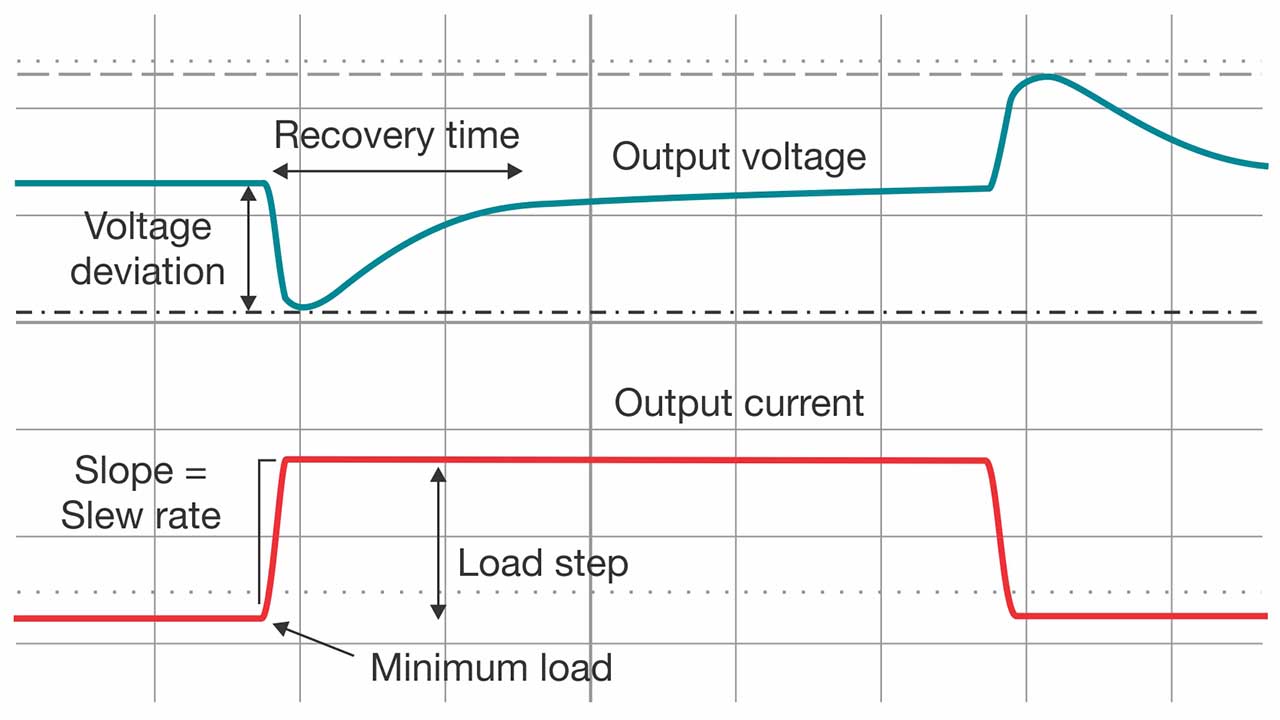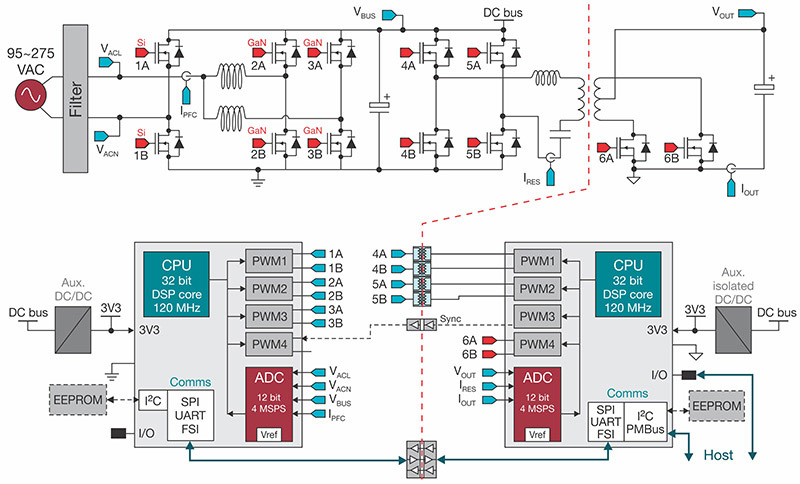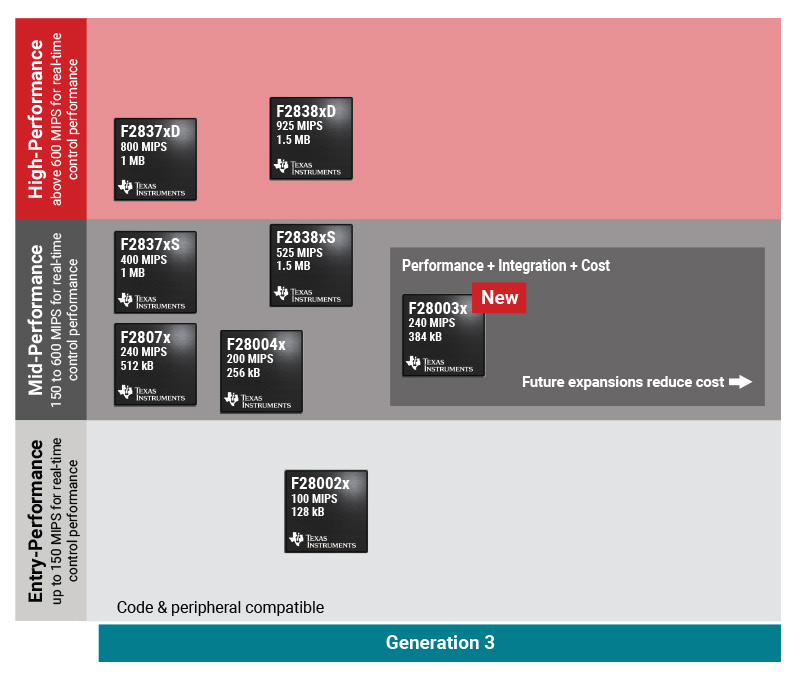SSZT123 October 2021 TMS320F2800137 , TMS320F280039 , TMS320F280039C , TMS320F280039C-Q1
- 1
-
2
- 3
- High-power Efficiency
- Fast Transient Response
- Higher Power Density with Larger Power Capacity
- Solving Server PSU Design Challenges
- Highly Accurate Sensing
- High-performance Processing
- Flexible, High-resolution Control
- Additional Benefits of C2000 Real-time MCUs in Server PSU Systems
- Conclusion
- Additional Resources

With the usage of servers and data centers growing globally, the need for stable and efficient power supplies has become an essential part of supporting the rise in power consumption. The utilization of power has been growing rapidly, with an increasing number of integrated central processing units, graphics processing units and accelerators needed to increase the calculation speeds of servers and data centers. Boosting the application benefits has spawned an evolution for power-supply units (PSUs) to deliver high power efficiency, fast transient response and high power density with larger power capacity.
High-power Efficiency
Server PSUs with high power efficiency can lower the costs and environmental impact of operating data centers by reducing power waste and enabling the maximum transfer of power from the source to the load. This capability enables data centers to meet tightening efficiency standards such as 80 Plus, achieve higher-than-average titanium efficiency in a wide load range, and release less carbon dioxide into the environment.
Fast Transient Response
In a server power application, having a fast transient response helps provide stable and reliable system operation under changing load and input transients. In addition, systems need to meet tighter transient response specifications of server power original equipment manufacturers: an 80% to 100% load jump at 2.5 to 5 A/µS. Figure 1 illustrates these parameters.
 Figure 1 Transient Response Parameters
Figure 1 Transient Response ParametersHigher Power Density with Larger Power Capacity
The growing power consumption of servers and data centers requires larger power capacity. Power technologies such as gallium nitride (GaN) are enabling smaller power supplies by allowing larger power capacity in a smaller space. Controlling the high switching frequency with a real-time microcontroller (MCU) is critical to achieving high power density in these systems and lowering the overall system bill of materials.
Solving Server PSU Design Challenges
To achieve these benefits, server PSU manufacturers face several design challenges, such as
- Implementing complex power topologies, such as totem-pole bridgeless power factor correction and control algorithms such as zero voltage switching, zero current switching, synchronous rectification timing and inductor-inductor-capacitor resonant DC/DC conversion with hybrid hysteretic control.
- Enabling real-time control performance for faster control-loop execution.
- Reducing power losses when adopting wide bandgap power devices like GaN and silicon carbide (SiC) while maintaining higher switching frequencies.
To meet the growing requirements of power efficiency and power density in server PSU systems, real-time MCUs need several key features, such as a low-latency signal chain, high pulse-width modulation (PWM) flexibility and resolution, high control-loop speeds and a high switching frequency. Figure 2 shows a sample PSU block diagram.
 Figure 2 Typical Dual-controller Architecture for a Server Power Supply with AC/DC and DC/DC Stages
Figure 2 Typical Dual-controller Architecture for a Server Power Supply with AC/DC and DC/DC StagesTMS320F280039C C2000™ real-time MCUs offer all of these traits while helping meet or reduce server PSU design budgets. They continue to improve integrated real-time signal chains (sensing, processing and control) through flexible and innovative capabilities. Figure 3 shows the F28003x family.
 Figure 3 F28003x MCUs expand the C2000 real-time MCU portfolio
Figure 3 F28003x MCUs expand the C2000 real-time MCU portfolioHighly Accurate Sensing
The F280039C MCU enables both high power efficiency and fast transient response times in server PSUs with its integrated analog components, including multiple 4-MSPS analog-to-digital converters with flexible start-of-conversion management, 11 effective number of bits and a post-processing block. The MCU also integrates fast analog comparators with optimized power-control features such a blanking, delayed trip, peak current-mode control and slope compensation for precise power conversion
High-performance Processing
Built on a 32-bit digital signal processor architecture combined with a control law accelerator, the F280039C offers over 240 MIPS of real-time performance, with features such as floating-point unit and trigonometric math unit to enable higher power density and high transient response with processing for complex time-critical calculations.
Flexible, High-resolution Control
Enabling larger power capacities and maintaining synchronization across phases, even at high frequencies, is paramount in high-wattage server PSU systems. The F280039C offers 150-ps resolution PWM channels with features such as valley switching, delayed trip, dead-time adjustment and global reload that allow precise control of complex power topologies and control algorithms. The integrated configurable logic block further enhances PWM flexibility and enables seamless interfacing with GaN technology to enable high power density.
Additional Benefits of C2000 Real-time MCUs in Server PSU Systems
Apart from trends in power management and fast real-time control, several other requirements are gaining traction in server PSUs that F280039C MCUs can achieve:
- Live firmware updates that enable seamless switchover to the new firmware without disrupting the power supply, and with minimal software overhead through multibank variants with several flash options and a faster flash bank erase time.
- Communication interfaces moving from PMBus to Controller Area Network (CAN) bus (and potentially CAN-FD) to allow faster speeds and high-data-rate, reliable host communication.
- Achieving security through encryption features (such as Advanced Encryption Standard, secure boot and Secure Joint Test Action Group) to address the industry's concerns of protecting code and data from external attacks in a more connected world.
Conclusion
The F280039C MCU expands on the C2000 MCU platform, offering integrated features that help you achieve advanced real-time control while reducing bill-of-materials costs. The F28003x MCU family complements the needs of wide bandgap technologies like GAN and SiC by unlocking their full potential to higher power efficiency and power density and faster response times. Easy-to-use software enables server PSU designers to accelerate development.
Additional Resources
- Check out these reference designs that can accelerate your development:
- 1-kW Reference Design with CCM Totem Pole PFC and Current-Mode LLC Realized by C2000 and GaN.
- 1-kW, 80 Plus Titanium, GaN CCM Totem Pole Bridgeless PFC and Half-Bridge LLC Reference Design.
- Live Firmware Update Reference Design with C2000™ Real-Time MCUs.
- Peak Current-Mode Controlled Phase-Shifted Full-Bridge Reference Design Using C2000 Real-Time MCU.
- Read the white paper, "Achieve Power-Dense and Efficient Digital Power Systems by Combining TI GaN FETs and C2000 Real-Time MCUs."
- Get a glimpse of the new F28003x real-time MCU
- Learn more about the TMS320F280039C.